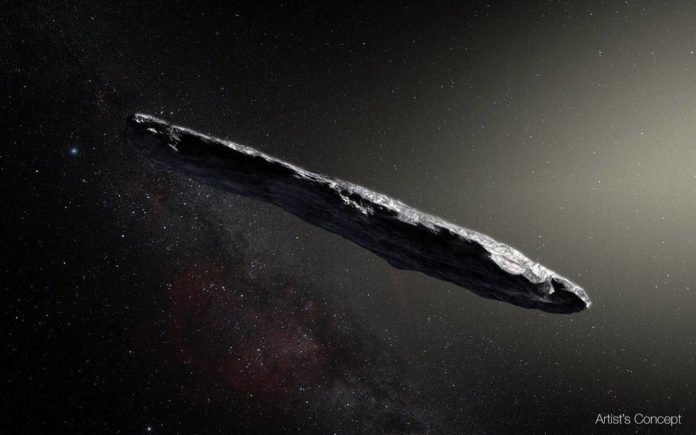For the first time, scientists have detected an asteroid that has entered the Solar System from interstellar space. Their data suggest that this rocky and cigar-shaped interstellar asteroid was traveling through space for millions of years before its chance encounters with our star system.
According to scientists, the interstellar visitor appeared as a dark reddish, highly elongated rocky or high-metal-content object. Scientists dubbed it as Oumuamua, which is up to a one-quarter mile (400 meters) long and highly-elongated—perhaps 10 times as long as it is wide.
The shape of this asteroid is quite surprising, but it may definitely provide new clues into how other solar systems formed.
On 19 October 2017, the Pan-STARRS 1 telescope in Hawaii got a swoon purpose of light moving over the sky. It at first resembled a commonplace quick-moving little space rock, however, extra perceptions throughout the following couple of days enabled its circle to be processed reasonably precisely.
The circle computations uncovered without question that this body did not begin from inside the Nearby planetary group, similar to every other space rock or comets at any point watched, however, rather had originated from interstellar space. Albeit initially named a comet, perceptions from ESO and somewhere else uncovered no indications of cometary action after it passed nearest to the Sun in September 2017. The protest was renamed as an interstellar space rock and named 1I/2017 U1 (`Oumuamua).
Thomas Zurbuchen, associate administrator for NASA’s Science Mission Directorate in Washington said, “For decades we’ve theorized that such interstellar objects are out there, and now – for the first time – we have direct evidence they exist. This history-making discovery is opening a new window to study the formation of solar systems beyond our own.”
When scientists found it, they immediately called other observatories around the world into action. They combined images from the FORS instrument on the ESO telescope using four different filters with those of other large telescopes. No known asteroid or comet from our solar system varies so widely in brightness, with such a large ratio between length and width. The most elongated objects we have seen to date are no more than three times longer than they are wide.
Karen Meech of the Institute for Astronomy in Hawaii said, “This unusually big variation in brightness means that the object is highly elongated: about ten times as long as it is wide, with a complex, convoluted shape. We also found that it had a reddish color, similar to objects in the outer solar system, and confirmed that it is completely inert, without the faintest hint of dust around it.”
After further detections, scientists found that the Oumuamua is traveling about 85,700 miles per hour (38.3 kilometers per second) relative to the Sun. Its location is approximately 124 million miles (200 million kilometers) from Earth — the distance between Mars and Jupiter – through its outbound path is about 20 degrees above the plane of planets that orbit the Sun.
The object passed Mars’s orbit around Nov. 1 and will pass Jupiter’s orbit in May of 2018. It will travel beyond Saturn’s orbit in January 2019; as it leaves our solar system. Further observations will continue until the object appears to be faint.
NASA Planetary Defense Officer Lindley Johnson said, “We are fortunate that our sky survey telescope was looking in the right place at the right time to capture this historic moment. This serendipitous discovery is bonus science enabled by NASA’s efforts to find, track and characterize near-Earth objects that could potentially pose a threat to our planet.”
Scientists suggest that such interstellar asteroid passes through the inner solar system about once per year, but they are faint and hard to spot and have been missed until now.
Paul Chodas, manager of the Center for Near-Earth Object Studies at NASA’s Jet Propulsion Laboratory, Pasadena, California, said, “What a fascinating discovery this is! It’s a strange visitor from a faraway star system, shaped like nothing we’ve ever seen in our own solar system neighborhood.”
